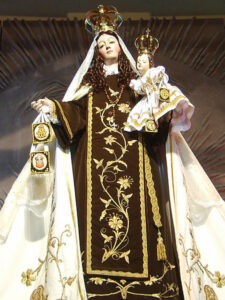Significance of the Carmelite way
 There are many Carmelite Orders, both male and female, in the Catholic Church of the Roman and Eastern Rites. The original Carmelites were an Order founded on Mount Carmel, by Berthold, a Crusader from Calabria, about the year 1155 A.D. They constitute the Order of the Brothers of Our Lady of Mount Carmel (Ordo Fratrum Beatissimæ Virginis Mariæ de Monte Carmelo, abbreviated O. Carm.) who were constrained to leave the area and settle in Europe.
There are many Carmelite Orders, both male and female, in the Catholic Church of the Roman and Eastern Rites. The original Carmelites were an Order founded on Mount Carmel, by Berthold, a Crusader from Calabria, about the year 1155 A.D. They constitute the Order of the Brothers of Our Lady of Mount Carmel (Ordo Fratrum Beatissimæ Virginis Mariæ de Monte Carmelo, abbreviated O. Carm.) who were constrained to leave the area and settle in Europe.
Thereafter the Order underwent many reform movements, the most important one being the one initiated by Teresa of Ávila and John of the Cross. They founded the Order of Discalced Carmelites (O.C.D.), also called Barefooted Carmelites, to differentiate them from their predecessors who were ‘calced’. There is also an Order of Cloistered Carmel nuns.
Interestingly, the Stella Maris Monastery presently on Mount Carmel in Palestine is considered the spiritual headquarters of the Carmelite Order.
The Carmelite charism is an important jewel in the Catholic crown. Here are some reasons why:
SPIRITUALITY: Centuries of Carmelite history shows us that longing and living for God is the essence of their spirituality. It is clear from the numerous exemplary lives of their confreres that it is indeed possible to encounter God very intimately. This is an experience attained through simplicity, detachment, contemplation, prayer and work, all of which produces an apostolic spirit, in many ways similar to the life led by Our Lady.
MODELS: The Carmelite Order has given several saints to the Catholic Church, among them mystic authors like Teresa of Ávila (1515-82) and John of the Cross (1542-91), who shine out as Doctors of the Church. Centuries later, Thérèse of Lisieux (1873-97, also known as Teresa of the Child Jesus and the Holy Face) whose highly influential model of sanctity marked by a simple and practical approach to the spiritual life also won her the title of Doctor of the Church.
Elsewhere in the world, the richness of the Carmelite spirituality was evidenced by Kuriakose Elias Chavara (1805-71), a Syro-Malabar priest of the Carmelites of Mary Immaculate (C.M.I), from Kerala, and by Edith Stein (1891-1942), a German Jewish philosopher who converted to Christianity and became a Discalced Carmelite nun.
LITERATURE: Several Carmelites have endowed us with the fruits of their study and contemplation, the chief among them being St Teresa of Ávila and St John of the Cross. To the former belong many poetical works and spiritual classics like The Way of Perfection and The Interior Castle, besides her engrossing autobiography; the latter author has to his credit poetic works like Spiritual Canticle and Dark Night of the Soul, and prose works like The Ascent of Mount Carmel, among others. Thérèse of Lisieux’s autobiography, The Story of a Soul, was published posthumously. In the monastery where she lived, Edith Stein was assigned the task of completing her autobiography, Life in a Jewish Family; she also wrote Finite and Eternal Being – An Ascent to the Meaning of Being and Science of the Cross, commenting on St John of the Cross and the Carmelite understanding of the depths of the soul.
MESSAGE TO THE WORLD: At the Apparitions in Fátima, whose full import the world is yet to understand, Our Lady of Mount Carmel appeared to Sister Lúcia holding the Brown Scapular. The famous visionary, who later became a Carmelite nun, stated that our Divine Mother wished everyone would wear it as a sign of their ‘consecration to her Immaculate Heart.’ For sure, the sacramental is a quiet and comforting reminder that Our Lady is always there for us.
There is therefore no doubt that we are in the presence of a prophetic Religious Order: The Carmelites!